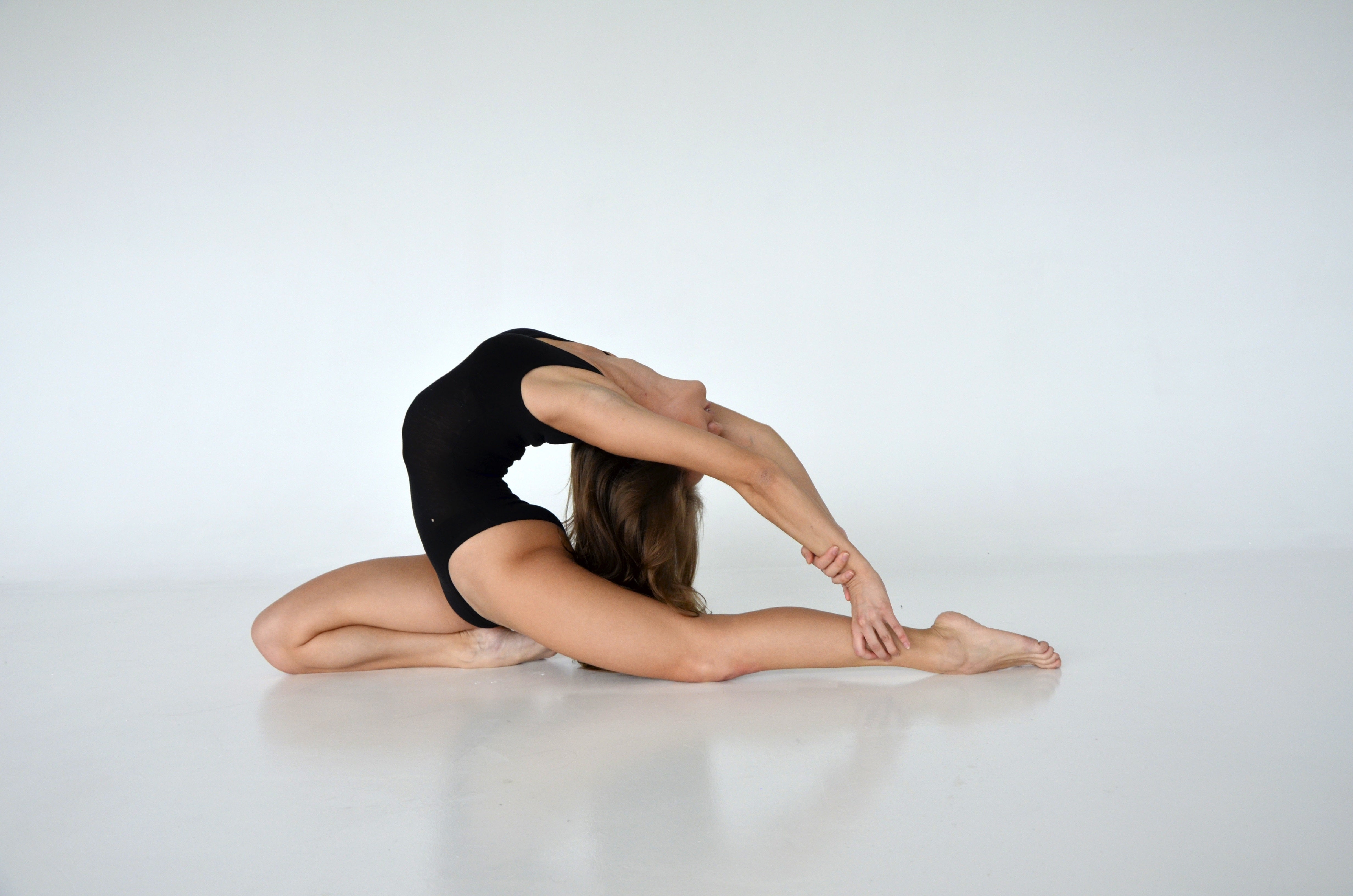
COMMON INJURIES IN HYPERMOBILE BACKS
Within the world of movement—the world all dancers, gymnasts, and physical artists share—mobility is essential. The freedom to move ‘beyond’ offers us the ability to express ourselves with a wider visual vocabulary.
However, like so many good things, improving flexibility and movement comes with its risks. Hypermobility—when it’s not combined with proper preparation and recovery methods—can pose unique challenges for the spine and back that often cause pain or restriction.
Today, we’re discussing those common injuries.
Whatever type of movement you’re passionate about, keeping your back healthy allows you to continue your practice, stay pain-free and improve. It’s hard to improve when you’re hurting. We want to save you that pain and restriction.
HYPERMOBILITY
Hypermobility refers to the ability to move your joints beyond ‘normal’ ranges. Many of those performing at the extremes of human movement are professionally hypermobile: it’s rarely optional for dance, gymnastics and acrobatics.
The problem is not hypermobility itself, but rather what occurs when these extreme ranges aren’t well-controlled. The other set of risks are in poor recovery—allowing the stress and strain of practise to degrade tissue over time.
The risks of this hypermobility tend to show up in hyperextension. Increased mobility allows you access to ranges in the spine that exceeds what human spines are designed to do. The ability to move into extreme positions involves risks most people don’t ever encounter—such as vertebrae-on-vertebrae contact and pressure.
THE UNIQUE PROPERTIES OF THE BACK
In the spinal region, these problems can become particularly problematic. 80% of people will experience debilitating lower back pain, at some point in life.
Healthy movements depend on a healthy spine, which is one area where mobility is already significant. Hypermobility includes the risk of putting your spine in extreme positions, which demands extreme control and preparation.
Not only that, but we often load these positions with a significant portion of bodyweight and hold them. These are unique loading positions and parameters that don’t show up in most people’s lives.
The spine is unique in its structure. It’s a stack of joints, and only two major structures support it:
1. The muscles of the core and back
2. The hips, an anchor to the spine
The injuries that afflict hypermobile spines are often a result of muscular or structural inadequacies in these two major structures. The need to compensate for weakness or poor control in the core, hips, and back are some of the most common causes of injury. They often subsist with improper recovery methods: not providing the environment and raw materials (nutrition) that the spine, hips and core musculature need to recover.
Injury risks go down when we treat recovery with the same intent as practice!
5 VULNERABLE AREAS OF INJURIES IN HYPERMOBILE BACKS
Injury 1: Pars
Spondylolysis— also called Pars fractures—happens when we place too much stress on the vertebrae. It occurs either based on the time spent in extreme positions or due to the compression placed on the spine.
Pars fracture risk has two primary components: the stress you’re putting on your spine through practise and movement and the rest and recovery you’re allowing after exercise.
The bones are just like muscles or tendons—they are alive and have their own recovery cycle.
Recovery in bones involves replacing damaged collagen and minerals lost through mechanical stress. Pars fracture risk increases when you’re stressing regularly without the rest, sleep, and nutrition to support the amount of stress you place on them.
Pars fractures are more common during hyperextension (excessive arching)—one of the extremes of spinal position common in dance and acrobatics. These positions require a strong core to maintain control and not let the spine ‘relax’ into a position that puts pressure on the tiny bone—pars interarticularis.
Injury 2: Facet Joint
The facet joint is a type of joint that holds vertebrae together. These stacked bones are attached at the back through membranes and ligaments. These tissues become inflamed through the same hyperextension and loading that puts you at increased risk of pars problems.
Other forms of movement, for example the combination of arching the back and impact from landing during tumbling, will add additional risk. If you’re not in control of your core and back, these risks increase as your vertebrae can move dynamically through positions you’re not controlling.
Facet joint syndrome develops when regular stress outpaces recovery, leading to chronic inflammation—or even degeneration—in the bones and ligaments. Like in previous injuries, they rely on proper nutrition, sleep, and rest to repair themselves and grow stronger. Protein intake, containing essential amino acids should be your main priorities. They are the building blocks of collagen and other essential tissue.
Injury 3: Nerves
The spine is your body’s protection for the spinal cord—the bundle of nerves that allows your body to function.
Nerve damages have serious medical implications. In hypermobile people and practices, these risks are higher because we’re moving in ways that push mobility and the spine to its limits.
Pinched, trapped, or compressed nerves can become a real problem with hypermobility since the positions of the vertebrae are prone to put pressure on the nerves, resulting in acute pain and loss of movement capacity if you’re not careful with how you respond to it.
You can reduce your risk of trapping or pinching nerves by improving core control. You should also decompress your spine regularly through directed stretching exercises—such as the cat stretch or deep standing pikes.

If you have access to stall bars, you can practice bar hangs and lower back stretches to get even better decompression. These are great for reducing tension in the muscles while also relieving pressure on the spine itself.
Injury 4: Discs
The discs between your vertebrae are there to space them out and prevent trapped nerves, absorb the shock to prevent fractures while maintaining your spine health in the long-term.
However, the discs themselves can become injured—they’re made up of collagen which degrades in response to loading. When you are in a hyperextended position, the loading on the spine produces this stress. Additional stress also comes from rotation of the spine—a common factor in sport, exercise and physical performance.
Spinal discs use both semi-liquid and solid collagen fibres, and recovery through rest, nutrition and collagen supplementation are crucial to handling the inflammation and stressful demands placed on these discs.
Degradation of the discs can cause them to become worn, ruptured or herniated as the solid collagen becomes weak and thin. Recovery, strengthening work and proper core control help you reduce stress. Recovery should be your top priority since you can’t always avoid some stress!
Injury 5: Sacro-Iliac joint (SIJ) and Hip
While they’re not strictly back pain, injury and dysfunction in the hips puts you at significant risk of back pain. The SIJ is where your spine anchors and problems in this area—weakness, rotational bias or poor control—all add up to increased back pain risk.
The SIJ is the flashpoint for poor loading and extreme positions in hypermobile people. Strains in the SIJ are common, painful and debilitating. These strains occur when the ligaments that hold your spine and hips together are stretched. Ligaments are non-elastic tissues, so stretching is a challenge for their long-term strength and health.
SJI strains can cause spasms in the back muscles, pain and weakness in the lower back specifically, and limited movement. A SIJ injury often develops out of weakness and poor control in the muscles around the hips.
WHAT CAN YOU DO ABOUT IT?
The risks of hypermobility are controlled and reduced through:
- Improving strength and control in the musculature around the spine and hips.
- Decompressing the spine after and between sessions.
- Improving your post-activity recovery and nutrition.
Improving Strength and Control
Strength and control are standard in gymnastic training because they help you control extreme ranges and reduce the risks associated with hypermobility. They build stability on top of flexibility, reducing your injury risk.
It’s not enough to build the muscle; you must focus on movement control and stability. One study found that the conscious effort towards developing control significantly reduced the risk of lower back pain, even compared to muscle-building training[1]. Reductions in back pain were two or more times more effective when control was a priority.
You must build the muscles to control the spine, both in the core and back. Your practice needs to concentrate on control, slow movement, working on isometric holds and vertebra-by-vertebra movement practice.
You also need to build up strength in the glutes, adductors and hip flexors. These components stabilise the position of the spine relative to the hips and preserve the lumbar spine—the bottom portion of your back—from the most debilitating injury risks.
Make sure you’re applying this preparation through all the movements of the spine: flexion and extension, rotation and lateral flexion. Don’t overlook any area—hypermobility requires hyperstability!
Decompressing the Spine
High-quality stretching routines must include decompression exercises for the spine. It helps relieve the pressure on the vertebrae, the discs between them and their joints.
It also combats the compression we all deal with daily and removes a lot of the tension due to hyperextension. Decompression sessions also mobilise the spine after exercise and release the tension and tone that can build up in the back muscles.
Recovery and Nutrition
Recovery through sleep and nutrition is key for better performance—from the elite athlete to the hobbyist.
Sleep isn’t optional: you need eight hours of quality, uninterrupted sleep in a dark, cool room. Sleep regulates the hormones that are involved in your connective tissue repair—building up the strength and active stiffness of tendons and ligaments alike.
Nutrition provides the raw materials for recovery processes. Your main focus should be abundant protein and a variety of vegetables—especially those rich in vitamin C. Two cups of spinach, for example, contains the average person’s daily vitamin C requirement. You should also consider tangerines, strawberries, and bell peppers—all of which are packed with vitamin C. Vitamin C is the regulating vitamin in collagen production. It helps your muscles, tendons and bones recover after exercise.
Collagen supplementation supports the soft tissue involved in flexibility practises, directly improving recovery. Collagen intake can also improve your body’s use of other nutrients, improving fat metabolism while aiding the recovery and strengthening of muscles, tendons, ligaments and bones.
FINAL THOUGHTS
We all risk debilitating back pain. The hypermobility of physical artists and mobility-dependent sportspeople create an even greater risk. Movement requires preparation and recovery. We need to give our bodies the habits and nutrients that protect us from these common problems.
A few shifts in lifestyle and training are worth the wellbeing of being pain-free for months and years to come!
REFERENCES
[1] Efficacy of the Multifidus Retraining Program in Computer Professionals with Chronic Low Back Pain














Leave a comment
This site is protected by hCaptcha and the hCaptcha Privacy Policy and Terms of Service apply.